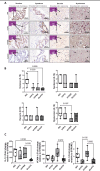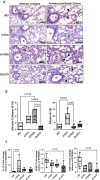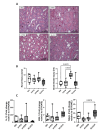Effects of different sodium concentrations in fluids on brain, lung, and kidney in experimental ischemic stroke
- PMID: 40691260
- PMCID: PMC12280188
- DOI: 10.1038/s41598-025-12491-9
Effects of different sodium concentrations in fluids on brain, lung, and kidney in experimental ischemic stroke
Abstract
Fluid administration is a key component in the management of acute ischemic stroke (AIS). However, the effects of different sodium concentrations in resuscitation fluids, particularly on distal organ function, remain controversial. This study compared the impact of four commonly used fluids-0.9% isotonic saline (ISO), 0.45% hypotonic saline (HYPO), 1.5% hypertonic saline (HYPER), and 5% glucose (GLUCO)-on perilesional brain tissue, lungs, and kidneys following AIS. AIS was induced in 28 male Wistar rats. Three hours after stroke induction, animals were randomized to receive one of the four fluids. In the brain, the ISO group showed significantly higher expression of versican and hyaluronan compared to the HYPER group (p = 0.022 and p = 0.018, respectively). Conversely, the HYPER group exhibited significantly elevated levels of interleukin-1β (IL-1β), vascular cell adhesion molecule-1 (VCAM-1), and zonula occludens-1 (ZO-1) compared to the GLUCO group (p = 0.01, p = 0.02, and p = 0.006, respectively). In the lungs, the ISO group demonstrated less alveolar collapse and pulmonary edema compared to the HYPER and HYPO groups (p = 0.01 and p = 0.007, respectively). In the kidneys, both the ISO and HYPO groups showed significantly less brush-border injury than the HYPER group (p = 0.007 and p = 0.032, respectively). Furthermore, blood chloride levels declined over time in the ISO group compared to the others. In conclusion, isotonic fluid administration resulted in the least amount of injury to the brain, lungs, and kidneys in this experimental model of AIS, supporting its use as a preferred resuscitation strategy in the acute phase.
Keywords: Acute ischemic stroke; Brain damage; Fluids; Inflammation; Sodium concentration.
© 2025. The Author(s).
Conflict of interest statement
Declarations. Competing interests: The authors declare no competing interests.
Figures




Similar articles
-
Perioperative buffered versus non-buffered fluid administration for surgery in adults.Cochrane Database Syst Rev. 2012 Dec 12;12:CD004089. doi: 10.1002/14651858.CD004089.pub2. Cochrane Database Syst Rev. 2012. Update in: Cochrane Database Syst Rev. 2017 Sep 21;9:CD004089. doi: 10.1002/14651858.CD004089.pub3. PMID: 23235602 Updated.
-
Efficacy and safety of isotonic versus hypotonic intravenous maintenance fluids in hospitalized children: an updated systematic review and meta-analysis of randomized controlled trials.Pediatr Nephrol. 2024 Jan;39(1):57-84. doi: 10.1007/s00467-023-06032-7. Epub 2023 Jun 26. Pediatr Nephrol. 2024. PMID: 37365423 Free PMC article.
-
Comparison of crystalloid resuscitation fluids for treatment of acute brain injury: a clinical and pre-clinical systematic review and network meta-analysis protocol.Syst Rev. 2018 Aug 17;7(1):125. doi: 10.1186/s13643-018-0790-x. Syst Rev. 2018. PMID: 30115113 Free PMC article.
-
Intravenous fluids for reducing the duration of labour in low risk nulliparous women.Cochrane Database Syst Rev. 2013 Jun 18;2013(6):CD007715. doi: 10.1002/14651858.CD007715.pub2. Cochrane Database Syst Rev. 2013. PMID: 23780639 Free PMC article.
-
Hypertonic salt solution for peri-operative fluid management.Cochrane Database Syst Rev. 2016 Jun 6;2016(6):CD005576. doi: 10.1002/14651858.CD005576.pub3. Cochrane Database Syst Rev. 2016. PMID: 27271480 Free PMC article.
References
-
- Hankey, G. J. Stroke in young adults: implications of the long-term prognosis. Jama309, 1171–1172. 10.1001/jama.2013.2319 (2013). - PubMed
-
- Hacke, W. et al. Association of outcome with early stroke treatment: pooled analysis of ATLANTIS, ECASS, and NINDS rt-PA stroke trials. Lancet363, 768–774. 10.1016/S0140-6736(04)15692-4 (2004). - PubMed
-
- Jauch, E. C. et al. Part 11: adult stroke: 2010 American heart association guidelines for cardiopulmonary resuscitation and emergency cardiovascular care. Circulation122, 818–828. 10.1161/CIRCULATIONAHA.110.971044 (2010). - PubMed
MeSH terms
Substances
LinkOut - more resources
Full Text Sources
Medical
Miscellaneous

